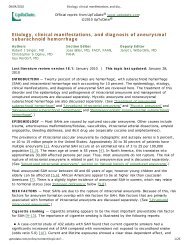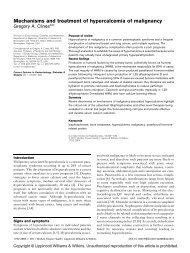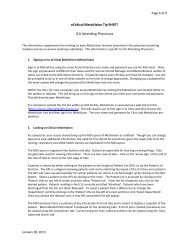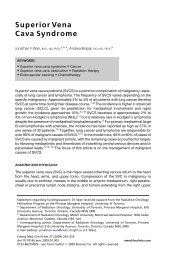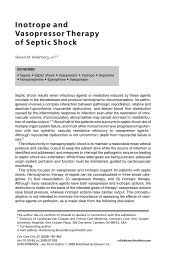Renal Physiology Figures.pdf - CriticalCareMedicine
Renal Physiology Figures.pdf - CriticalCareMedicine
Renal Physiology Figures.pdf - CriticalCareMedicine
You also want an ePaper? Increase the reach of your titles
YUMPU automatically turns print PDFs into web optimized ePapers that Google loves.
RENAL PHYISOLOGY<br />
FOR CRITICAL CARE<br />
MEDICINE RESIDENTS:<br />
FIGURES
Lecture 1 – Glomerular Filtration Rate<br />
As blood flows through the capillary, the colloid osmotic pressure increases until it equalizes with<br />
capillary hydrostatic pressure. <strong>Figures</strong> A and B represent the same concept but with two different<br />
kinetics. This difference is irrelevant for the purposes of the talk.
Lecture 2 – The <strong>Physiology</strong> of the Glomerular Tuft<br />
Cross section of the glomerular tuft. AA – afferent arteriolar, EA – efferent arteriole, MD – macula<br />
densa, M – mesangium, F – foot process, BM – basement membrane, EN – endothelium, EP –<br />
epithelium, PT – proximal tubule
Lecture 4 - Adenosine and Tubuloglomerular Feedback in the Pathophysiology of Acute <strong>Renal</strong> Failure<br />
Signal transduction in tubuloglomerular feedback
Lecture 5 – The <strong>Physiology</strong> of the Proximal Tubule<br />
Mechanism for bicarbonate reabsorption. Apical membrane and tubular lumen are on the left and<br />
basolateral and basement membrane is on the right.
Lecture 6 - The <strong>Physiology</strong> of the Loop of Henle<br />
Mechanism for counter current exchange and secretion and reabsorption of water and solutes.
Cellular transport for solutes in the proximal tubule.
Lecture 7 – The <strong>Physiology</strong> of the Distal Tubules and Collecting Ducts<br />
Principle cell
Intercalated cells – Type A on top and Type B on the bottom



